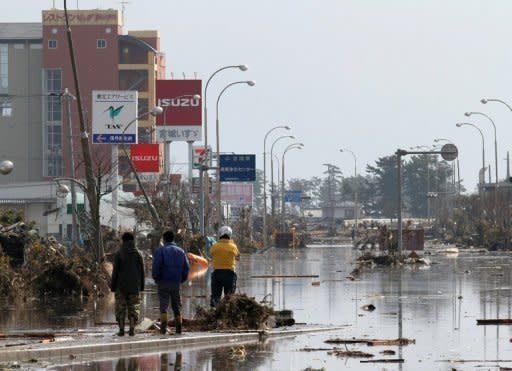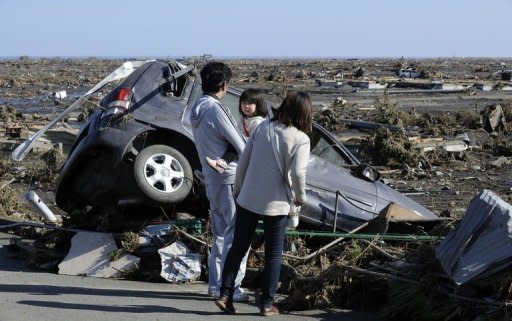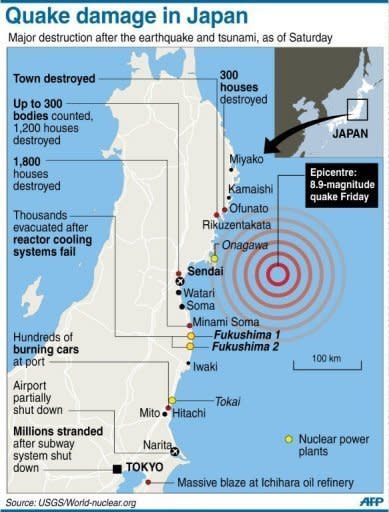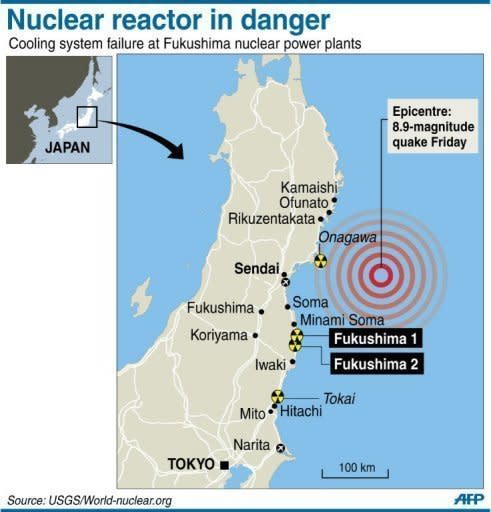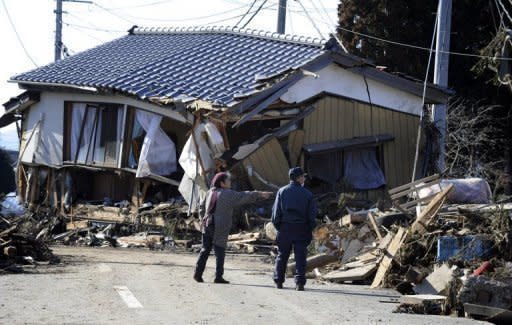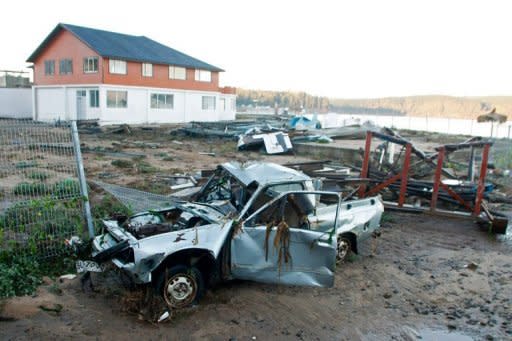Japan quake: live report
1700 GMT: A recap of the day's events so far in the aftermath of Friday's massive 8.9-magnitude quake -- the most powerful ever to strike Japan -- which struck off the north-east coast of the country's main Honshu island, unleashing a 10-metre (33-foot) tsunami that tore through towns and cities on Japan's Pacific coast. - An explosion at nuclear plant triggered fears of a meltdown Saturday, after the earthquake and tsunami left more than 1,000 dead and at least 10,000 unaccounted for. - Smoke billowed from the Fukushima No. 1 atomic plant about 250 kilometres (160 miles) northeast of Tokyo, after an explosion blew off the roof and walls of the structure around the reactor. - Tens of thousands of residents were evacuated within a 20-kilometre radius of the stricken plant, and thousands more were shifted from another damaged plant, Fukushima No. 2. - Japan's nuclear safety agency rated an accident at the earthquake-hit nuclear plant at four on the international scale from 0 to 7, an official said Sunday. - Kyodo and Jiji reported before the explosion that the plant "may be experiencing nuclear meltdown", while NHK quoted the safety agency as saying metal tubes that contain uranium fuel may have melted. - Japan's Prime Minister Naoto Kan said the chaos unleashed by Friday huge quake was an "unprecedented national disaster". - In the small port town of Minamisanriku alone, some 10,000 people are unaccounted for -- more than half the population -- public broadcaster NHK reported. - International search and rescue teams rushed to Japan Saturday in the wake of the disaster, while one of Afghanistan's most violent provinces offered $50,000 in aid. A 66-strong Japanese team which has spent more than two weeks searching the rubble left by last month's 6.3-magnitude quake in Christchurch in New Zealand was making hasty preparations to return home to confront the unfolding tragedy. 1630 GMT: The impact of the 8.9-magnitude quake may now threaten Japan's economic recovery that was seen to be gathering momentum in the first quarter of this year after losing steam in the fourth quarter of 2010, my Tokyo colleagues report analysts as saying. "The timing of the disaster could not have been much worse," Capital Economics noted in a research report. Analysts say it will take weeks to get a firm handle on the true extent of the damage inflicted on the nation and its economy. "Temporary closures of factories and oil refineries and the shutting down of power stations are likely to affect output throughout the country," noted Wolfgang Leim of Commerzbank. "Economic output may therefore shrink again slightly in the first quarter." 1620 GMT: Japan's nuclear safety agency has rated the accident at the earthquake-hit nuclear plant northeast of Tokyo at 4 on the international scale from 0 to 7, my colleagues in Tokyo report an official as saying. 1600 GMT: International search and rescue teams rushed to Japan Saturday in the wake of Friday's huge 8.9-magnitude earthquake and devastating tsunami, while one of Afghanistan's most violence-wracked provinces offered $50,000 in aid. A 66-strong Japanese team which has spent more than two weeks searching the rubble left by last month's 6.3-magnitude quake in Christchurch in New Zealand was making hasty preparations to return home to confront the unfolding tragedy. The United States said it was sending nearly 150 rescue workers to the disaster zone, among them a team from Los Angeles that had only returned from New Zealand two days ago. From Britain's Queen Elizabeth II, to the Dalai Lama and entertainer Lady Gaga, the world has rallied to support Japan, where tsunami waves up to 10 metres (33 feet) high rolled across the low-lying northeast of the main Honshu island on Friday. 1530 GMT: The tsunami has caused a storm surge in the Galapagos islands but largely spared Latin America from major damage, my colleagues report from Los Angeles. Ecuadoran President Rafael Correa said the surge may have affected some dwellings but "has not endangered human life." Chile, Ecuador and Peru ordered evacuations of coastal areas and Ecuador also halted oil shipments amid fears of rough seas. Peruvian officials said the first wave of around 40 centimeters (15 inches) hit around 0050 GMT Saturday, after some coastal areas were evacuated. President Alan Garcia said earlier he saw "no enormous danger" from the tsunami. In Mexico, no casualties or damages were reported as waves up to 70 centimeters (2.2 feet) high arrived on coastal areas of Baja California. In Central America, the force of the tidal wave was "not as strong as expected," said Nicaraguan President Daniel Ortega. Guatemala and Panama lifted their tsunami alerts and in El Salvador, the government said "the danger is past." 1450 GMT: At least three residents evacuated from a town near the quake-hit Fukushima No. 1 nuclear plant in the northeast of Japan's main Honshu island have been exposed to radiation, public broadcaster NHK reported Saturday. The three were randomly chosen for examination out of some 90 bedridden patients moved from a hospital in the town of Futaba-machi, Fukushima Prefecture. The patients had waited for rescuers in a school's ground, spending a long time outside and then being moved by helicopter at the time when an explosion hit the ageing plant, NHK said, citing the Fukushima local government. The explosion sent plumes of smoke spewing from the nuclear power plant Saturday, raising fears of a possible meltdown a day after a massive quake struck the facility's cooling system. The government declared an atomic emergency and said tens of thousands of people living within 20 kilometres (12 miles) of the plant should leave. The operator of the nuclear plant said the container surrounding the reactor was not damaged despite the explosion. 1415 GMT: My colleagues in Tokyo are reporting that Japan's national football coach Alberto Zaccheroni and his coaching staff are flying home to Italy following Friday's huge earthquake in Japan. Zaccheroni said Saturday his family and those of his staff in Italy had been "terribly worried", before he left for home with his four Italian assistants. The 57-year-old former AC Milan boss added: "We have decided to go home on a temporary visit with approval from the Japan Football Association to assure our families that we are all right." Their return date has not been fixed but Zaccheroni was scheduled to announce his squad in Tokyo on Thursday for the March 25 and 29 home friendly matches against Montenegro and New Zealand. 1345 GMT: More detail from my colleagues in Tokyo on public broadcaster NHK's report that more that 10,000 people are unaccounted for in Minamisanriku in quake-hit Miyagi Prefecture. The figure is more than half of the population of roughly 17,000 in the town on the Pacific coast, the report said. Local authorities are trying to find their whereabouts with the help of Self-Defence Forces, NHK said. Authorities have so far confirmed that around 7,500 people were evacuated to 25 shelters after Friday's quake, but they have been unable to contact the other 10,000, NHK said. 1330 GMT: Around 10,000 people are unaccounted for in the Japanese port town of Minamisanriku in Miyagi Prefecture, Japan's public broadcaster NHK is reporting, following Friday's huge earthquake. 1305 GMT: Japan's Premier Naoto Kan on Saturday urged calm among people living near a nuclear power plant hit by an explosion and vowed the government would do its best to protect public health. "By taking firm measures, we will do our best not to have even a single person suffer from health problems," the centre-left premier said, after tens of thousands of residents were evacuated from around the Fukushima No. 1 plant north of Tokyo. "From the bottom of my heart, I would like everybody to listen to the government and to media reports and to act calmly," he said in a televised press conference on the quake and tsunami calamity. 1235 GMT: Japan's Prime Minister Naoto Kan says the massive earthquake and tsunami that devastated vast areas of Japan and shocked the world was an "unprecedented national disaster". "I want the people to overcome this quake, which must be called an unprecedented national disaster, by utilising the strengths of each of you, together with the utmost efforts of the government and the related agencies that it supports," Kan said in a televised address to the nation. 1210 GMT: The operator of a stricken nuclear plant north of Tokyo on Saturday said a reactor container was not damaged despite a large explosion at the plant, Japan's chief cabinet secretary said Saturday, my colleagues in Tokyo report. Yukio Edano added that radiation levels near the Fukushima plant had fallen after the blast, amid fears of a possible nuclear meltdown following a devastating earthquake and tsunami Friday. 1145 GMT: Tsunami waves from Japan's huge quake have killed at least one person and sparked mass evacuations on the American continent, but failed to inflict major damage, my colleagues in Los Angeles report. Surges of eight feet (2.4 meters) high crashed ashore on the coasts of California and Oregon Friday, up to 12 hours after the 8.9-magnitude quake triggered tsunami alerts in dozens of countries across the Pacific. In California's Del Norte County, a 25-year-old man was confirmed dead after being swept into the Pacific Ocean near the mouth of the Klamath River. The man and two friends were taking photographs of the incoming tsunami waves. "We have at least 35 boats that have been crushed. We have boats on top of other boats," said Cindy Henderson, emergency services manager in Crescent City, 350 miles north of San Francisco. 1115 GMT: A US radiation expert says cooling is the key to averting disaster at the quake-hit nuclear plant in Japan, my colleagues in Hong Kong are reporting. The Fukushima No. 1 plant, located about 250 kilometres (160 miles) northeast of Tokyo, was hit by an explosion Saturday, raising fears of a radioactive meltdown, a day after a huge quake damaged its cooling system. Ron Chesser, director for the Center of Environmental Radiation Studies at Texas Tech University, was the first American scientist allowed inside the exclusion zone in 1992 in Ukraine following the Chernobyl disaster. "The fact they're having trouble cooling the reactors is going to trigger an emergency," Chesser told the ScienceDaily website in the US. Chesser said that though reports have said the plant's reactors were shut down safely, the reactors must still be cooled constantly to avoid a meltdown of the core. "There are certain trigger points for declaring an emergency at nuclear reactors. Reduction in cooling capacity would be one of those. Release of radiation would be another. "Reactors are not like your car that you can turn off and walk away. They're going to continue generating a great amount of heat until the core is disassembled. "Without cooling water, then you stand a real chance of a meltdown of core that could result in a large release of radiation, potentially." 1045 GMT: Japan's Nuclear and Industrial Safety Agency are saying serious damage to the stricken Fukushima No. 1 reactor container was unlikely despite a large explosion at the plant north of Tokyo, Kyodo News agency is reporting. 1030 GMT: Japan's Self Defence Forces say troops have found 300 to 400 bodies in the coastal city of Rikuzentakata, which was virtually wiped out by a massive tsunami, broadcaster NHK reports. 1012 GMT: The evacuation radius at the damaged nuclear plant in northeastern Japan has been widened to 20 km (12 miles), the public broadcaster NHK is reporting. 1000 GMT: Just to reiterate earlier information reported in 0902 GMT post, Japan's Kyodo News agency are saying the hourly radiation level at the damaged nuclear power plant in Fukushima Prefecture 'matches the allowable annual dose.' 0945 GMT: Nuclear authorities had earlier warned that the Fukushima No. 1 plant, located about 250 kilometres (160 miles) northeast of Tokyo, an urban area of 30 million people, "may be experiencing a nuclear meltdown", my colleagues are reporting from Tokyo. The plant's cooling system was damaged in the quake that hit Friday, leaving the government scrambling to fix the problem and evacuate more than 45,000 residents within a 10-kilometre (six-mile) radius. Public broadcaster NHK reported that a blast had been heard at about 3:30 pm (0630 GMT) and showed delayed footage of smoke billowing from the site, then reported that the reactor building had been destroyed. Operator Tokyo Electric Power confirmed the explosion and that the roof of the reactor building had collapsed, saying this had happened during an aftershock to Friday's quake, Kyodo News reported. 0930 GMT: A nuclear power plant in northeastern Japan has been hit by an explosion, raising fears of a radioactive meltdown, a day after a massive quake damaged the facility's cooling system. A top government spokesman said tens of thousands of people within 10 kilometres (six miles) of the plant should evacuate, calling for a "calm response", and saying radiation was "at assumed levels". Kyodo News agency are saying the hourly radiation matched the allowable annual dose. TV channels warned nearby residents to stay indoors, turn off air-conditioners and not to drink tap water. 0925 GMT: This is Nick Morrison in London taking over the live report on the aftermath of Friday's massive 8.9-magnitude earthquake that struck off the northeast coast of Japan, sparking a 10-metre (33-foot) tsunami which has devastated the Pacific coastlines of Miyagi and Fukushima prefectures on the country's main Honshu island. There are reports coming out of Japan that there has been an explosion at Fukushima No.1 nuclear plant as a result of th damage caused by the earthquake. 0907 GMT: The government is saying the Tokyo Fire Dept. is sending its 'hyper rescue team' to the damaged nuclear plant 0902 GMT: Kyodo News agency is reporting that the hourly radiation at the damaged nuclear plant matches allowable annual dose 0844 GMT: AFP reporter Hiroshi Hiyama in Minamisoma says an eerie calm has descended over the muddy wastelands, with locals recalling their ordeal. - Sayori Suzuki, a 34-year-old housewife, told AFP it was something she had "never experienced before. My son cried violently and things just flew from the shelves. My house is okay, but a relative's house was washed away. Another relative said he was fleeing in a car but watched in the rear-view mirror as the waves were catching up on him from behind. He escaped very narrowly." 0827 GMT: Japan TV channel is warning people to stay indoors near the nuclear plant 0822 GMT: NHK is reporting that the walls and roof of the quake-damaged nuclear plant have been destroyed in a blast 0800 GMT: NHK is reporting that several workers have been injured in a blast at the quake-hit nuclear plant. 0754 GMT: Television is now reporting that radioactivity at the quake-hit nuclear plant is 20 times normal level 0753 GMT: Japanese television footage is showing smoke billowing from the Fukushima No.1 nuclear plant 0750 GMT: Jiji Press news agency is reporting that an explosion was heard and white smoke was seen at the quake-hit Japan nuclear plant 0725 GMT: Tibetan spiritual leader the Dalai Lama has joined a chorus of sympathy expressing his "shock and sadness." 0712 GMT: All along the eastern coast of the Philippines nearly a quarter of a million people returned to their homes as the threat of a tsunami subsided. 0630 GMT: In the quake-hit areas, 5.6 million households had no power and more than one million households were without water. 0615 GMT: Data compiled by AFP from national and provincial police shows that at least 703 people have been confirmed killed. 0558 GMT: NHK quotes Tokyo University professor Naoto Sekimura as saying that "only a fraction of the fuel may have melted but the reactor had already been stopped and is being cooled. I urge residents to act calmly." 0555 GMT: Public broadcaster NHK quoted the Nuclear and Industrial Safety Agency as saying that metal tubes, called 'fuel cladding', which contain uranium fuel may have melted. 0540 GMT: A TEPCO spokesman tells AFP that "we believe the reactor is not melting down or cracking. We are trying to raise the water level." - Kyodo News agency moments later said radioactive caesium had been detected near Fukushima plant, citing the nuclear safety commission. 0539 GMT: Japan's Jiji Press news agency says parts of the reactor's nuclear fuel rods were briefly exposed to the air after cooling water levels dropped through evaporation, and a fire engine was pumping water into the reactor. - The water levels are recovering, says operator Tokyo Electric Power, according to Jiji. 0528GMT: Japanese quake-hit nuclear power plant Fukushima No. 1, about 250 kilometres (160 miles) northeast of Tokyo, "may be experiencing nuclear meltdown", Kyodo and Jiji news report. 0512GMT: The defence ministry says about 1,800 homes in Minami Soma, Fukushima prefecture, were destroyed, while in Sendai authorities said 1,200 houses were toppled by the tsunami. - Thousands more homes were destroyed in a string of coastal towns -- including Ofunato, which on Friday reported 300 houses collapsed or swept away. 0503 GMT: The death tool has gone up with at least 613 people confirmed killed, but Prime Minister Naoto Kan's right-hand man and top spokesman, Chief Cabinet Secretary Yukio Edano says "it is believed that more than 1,000 people have lost their lives". 0450 GMT: The scale of the tragedy is sparking words of encouragement and support from around the world, both from leaders like Queen Elizabeth II, US President Barack Obama, who has offered emergency aid, and Australian Foreign Minister Kevin Rudd who has said his government is "prepared to throw anything and everything at this," to superstar entertainer Lady Gaga. who has launched a bracelet fund, R&B icon Alicia Keys wrote on her Twitter account "My heart breaks for Japan," and Canadian teen idol Justin Bieber who Tweeted Japan "one of my favorite places on Earth." 0439 GMT: A colleague in Wellington is reporting that a Japanese search and rescue team which has just spent the last two weeks scouring the rubble in the quake devastated city of Christchurch in New Zealand, is making hasty preparations to return home to confront the latest tragedy, this time sadly on its home soil. 0430 GMT: Even as the relief effort gets under way with international rescue teams rushing to help, the sheer extent of the damage is reflected in reports from my colleagues in Tokyo and elsewhere who talk of the "utter bleakness of the east coast" with "entire neighbourhodds destroyed," reminders of nature's cruelty against this seismically unstable nation. - But even among the bleakness there are glimmers of good news; a group of people rescued by helicopter from the roof of an elementary school in Watari, Miyagi prefecture, and naval and coastguard choppers rescuing 81 people from a ship hurled out to sea by the tsunami. 0407 GMT: Japanese Prime Minister Naoto Kan has returned from a helicopter tour to see the devastation talking of the "huge extent" of the damage. "What used to be residential areas were mostly swept away in many coastal areas and fires are still blazing there," he told his cabinet ministers. - Elsewhere rescue teams and the military have mobilised to start a Herculean rescue and recovery effort, with the Self Defence Forces throwing everything into the frantic effort, with hundreds of ships, planes and vehicles headed to the Pacific coast. 0352 GMT: Police in Japan are now saying that more than 215,000 people are taking refuge in emergency shelters 0325 GMT: After sounding warnings and urging people to leave coastal areas, Pacific nations are starting to breathe a sigh of relief as the feared destruction from the tsunami turns out to be more of a curiosity than a danger. - In the New Zealand the first wave "was rather insignificant and hardly visible to the naked eye," according to civil defence operations manager David Coetzee. - In Tonga, where a tsunami that killed nine people 18 months ago remains fresh in the memory, many people rushed to higher ground for safety while others tested the power of the tsunami by going for a swim. "The current was flowing differently and you could feel it in the water," said Matangi Tonga editor Pesi Fonua who entered the water near the capital Nuku'alofa. 0306 GMT: My colleagues in Manila are saying that over 55,000 residents of the Philippines east coast are starting to return home after spending an uncomfortable night in temporary shelters inland because of fears of tsunami waves. - Waves did strike the country, where residents are no stranger to natural disasters, in the early evening Friday but fortunately there were no reports of any damage of casualties. 0242 GMT: The US Geological Survey is saying the aftershock hit at a depth of just 24 kilometres (15 miles), and was centred 174 kilometres east-southeast of the city of Sendai. 0216 GMT: The USGS has said that an aftershock measuring 6.8 has hit off the Japanese coast 0209 GMT: Reports continue to come in from the other side of the Pacific from Japan where tsunami waves caused locals and toursists to scramble to high ground in Hawaii, and surges of 8 feet (2.4 meters) have been reported in California and Oregon. - California's governor Jerry Brown, meanwhile, has declared a state of emergency in four of the state's coastal counties -- a procedure that unblocks federal funds to help with the clean-up. - Even Canada has issued an alert for the north coast of British Columbia, warning it may "produce strong currents dangerous to those in or near the water." 0149 GMT: The AFP office in Mexico City says the tsunami from Japan's earthquake has swept across the Pacific and washed up in Mexico and Central America. The first waves have fortunately not caused any major damage but Chile, Ecuador and Peru are taking no chances and have ordered ordered evacuations of coastal areas and extra precautions for outlying islands. 0129 GMT: Radioactive steam is released at a second Japanese plant to ease reactor pressure, Jiji reports 0125 GMT: AFP is re-opening its Live Report on the situation in Japan as officials scramble to prevent nuclear accidents at two atomic plants where reactor cooling systems failed after the massive earthquake. - Radiation 1,000 times above normal was detected in the control room of one plant, although authorities said levels outside the facility's gates were only eight times above normal, spelling "no immediate health hazard". - Tokyo Electric Power, which runs the plants, said it had released some radioactive vapour intothe atmosphere at one plant to relieve building reactor pressure, but said the move posed no health risks. - The government declared an atomic emergency amid growing international concern over its reactors after an 8.9 magnitude earthquake, the biggest in Japan's history, unleashed tsunamis that swept all before them. - The US Air Force, which has many bases in Japan, delivered coolant to a Japanese nuclear plant, US Secretary of State Hillary Clinton said Friday, without specifying which plant. - The two nuclear plants affected are the Fukushima No. 1 and No. 2 plants, both located about 250 kilometres (160 miles) northeast of greater Tokyo, an urban area of 30 million people. - The evacuation area was expanded. A total of 45,000 people living within a 10-kilometre (six-mile) radius of the No. 1 plant were told to evacuate -- raising the number from the fewer than 6,000 people within three kilometres told to leave Friday.


